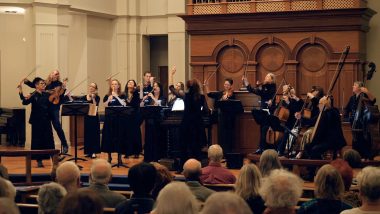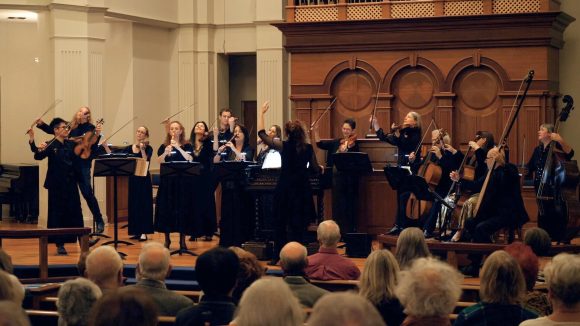 United Kingdom Vivaldi, Bach – ‘Fire & Joy’: Deborah Nagy (oboe), Nicole Divall (viola d’amore), Alan Choo, Edwin Huizinga (violins) Daphna Mor, Kathie Stewart (recorders), René Schiffer (cello), Apollo’s Fire / Jeannette Sorrell (conductor). First United Methodist Church, Akron, Ohio, 11.16.2023. (MSJ)
United Kingdom Vivaldi, Bach – ‘Fire & Joy’: Deborah Nagy (oboe), Nicole Divall (viola d’amore), Alan Choo, Edwin Huizinga (violins) Daphna Mor, Kathie Stewart (recorders), René Schiffer (cello), Apollo’s Fire / Jeannette Sorrell (conductor). First United Methodist Church, Akron, Ohio, 11.16.2023. (MSJ)

Vivaldi – Concerto in D minor for Two Violins & Cello, RV565 (Choo, Huizinga, Schiffer); Concerto in D minor for Viola d’amore, RV394 (Divall)
Bach – Concerto in F major for Oboe, BWV1053r (Nagy); Brandenburg Concerto No.4 in G, BWV1049 (Choo, Mor, Stewart); Sinfonias BWV152, 182, 196
Marketers need to come up with a way to publicize concerts, and it is often done by giving a program an overarching title that suggests a unifying theme. For many ensembles, that title is often more overreaching than overarching. It is notable that Apollo’s Fire can bill a concert as ‘Fire & Joy’, and then actually deliver on those strong descriptors.
The program admirably mixed famous and lesser-known pieces, closing with a chestnut, Johann Sebastian Bach’s Brandenburg Concerto No.4. This performance was of the sort that poses a real challenge to a reviewer who has twice heard Apollo’s Fire perform the piece in the past. Those renditions were outstanding, and one might think they would be hard to top, but this is not a group that rests on its laurels. They looked anew and dug deeper into this masterpiece.
A few things to consider. It has been a joy watching violinist Alan Choo over the last few years move from talented newcomer to vivid master. He had brilliant technique when he joined Apollo’s Fire, but working with Jeannette Sorrell and her ensemble has unlocked his ability to project vivid emotion and drama. This concerto offers some ferocious passages for the violinist and suffice it to say that Choo could have taken on both the Devil and Johnny from the Charlie Daniels song ‘The Devil Went Down to Georgia’ and left them behind, sputtering in the dust. Yet – and this is perhaps an even greater achievement – he had the wisdom and grace to know when to drop back and let recorder players Daphna Mor and Kathie Stewart take the lead. How Mor and Stewart can transform those notorious torture whistles into the sweetest floating voices defies belief. It is beyond technical precision, which they have in hand. They also bring a flexibly human feel to the recorder lines, and that is something not often encountered in this work.
A further mark of the performance is how one could focus deep in the ensemble and still feel like each person was animating the music in a personal and committed way. René Schiffer at one point played a single cello note in the bass line in such a way that it felt like the dramatic center of the work, if not the entire concert. I don’t think I was alone when a sense of elation began to creep over me, a sense that the very atoms around us began dancing with the deep joy of this performance. Audience reaction was explosive.
Choo had been joined by Edwin Huizinga and Schiffer in the opening work on the program, Antonio Vivaldi’s concerto RV565. It is the peculiar concerto that opens with a short, fast rhapsodic exchange between the two violins before moving to a nervously alert, slow section. This concerto so fascinated Bach that he made his own arrangements of it, and the ecstatic, intertwining violin writing clearly influenced him tremendously. As always with Sorrell’s direction, soloists are paired with great care for complement and contrast. That was certainly true for Choo and Huizinga, and it was striking how inverse the contrasts were. Choo, while a dynamo of energy, is physically slight: his big sound and dramatic energy emerge from an instrument controlled by a small body. Huizinga towered over everyone else on stage by at least half a foot, yet his sound and style are graceful and inward, offering tenderness against Choo’s fire. It was a perfect contrast, making it easier to follow each musical line. Schiffer was step for step with them expressively and technically, and Sorrell shaped the piece with a sure hand.
I have to keep digging in my bag for superlatives, because Deborah Nagy was no less excellent in the reconstructed oboe concerto in F by Bach. This piece is more familiar in its final form as the Keyboard Concerto No.2 in E, but it has been recognized by scholars that Bach’s keyboard concertos were his own arrangements of various earlier works now lost, and it is possible to reconstruct those pieces. Because of the melodic figurations and the range of the notes used, it is thought that the second keyboard concerto was originally an oboe concerto, pitched up a half step to better fit the instrument. This performance made a convincing case for the reconstruction, Nagy deftly interplaying with the rest of the ensemble, aerating the sound with her mellow tone. The oboe is probably the instrument that changed most to its modern equivalent over the centuries. The modern oboe has a much more penetrating sound which helps in large halls, but the more colorful sound of the period oboe is enchanting, and Nagy makes it speak. Particularly moving was the siciliano second movement which became breathtakingly otherworldly.
The other Vivaldi concerto on the program was the viola d’amore concerto in D minor, played with verve by Nicole Divall. The viola d’amore is a rare instrument from the seventeenth century that includes resonating strings beneath the notated strings. The resonance this gives is a subtle halo of sound, a sort of gentle watercolor haze surrounding its notes. The Akron First United Methodist Church was a good venue for the instrument, whose subtle colors likely would not transmit to a larger hall. Sorrell sat to the side to let the more intimate ensemble for this concerto bring it to life, which they did. Divall made the most of the viola d’amore’s colorful expression, while demonstrating that it can also leap with agility like any other string instrument.
The entire program was linked with Bach sinfonias from the cantatas, which Sorrell had selected for their instrumentation and suitability for use as introductions to the bigger pieces. This kind of visionary shaping of the entire program might be described as routine for Sorrell, except that there is never anything routine about her programs. She brings restless creativity to everything she does and has found like-minded allies to join her in her explorations. They are a gift.
Mark Sebastian Jordan

Wow! An amazing review!! Mmmm. That René Schiffer!!!